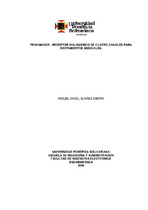| dc.contributor.advisor | Restrepo Agudelo, Raúl | |
| dc.contributor.author | Suárez Sierra, Miguel Angel | |
| dc.coverage.spatial | Seccional Bucaramanga. Universidad Pontificia Bolivariana. Escuela de Ingenierías. Facultad de Ingeniería Electrónica | spa |
| dc.coverage.temporal | 2008 | |
| dc.date.accessioned | 2013-06-21T20:23:08Z | |
| dc.date.available | 2013-06-21T20:23:08Z | |
| dc.date.created | 2008-04-16 | |
| dc.date.issued | 2013-06-21 | |
| dc.identifier.uri | http://hdl.handle.net/20.500.11912/319 | |
| dc.description | 111p.: (pdf); il; gráficas; tablas; anexos | spa |
| dc.description.abstract | Al hablar de transmisión de información la preocupación mayor de los diseñadores es el ruido y al tratar de mejorar este, aparecen otros tipos de modulación como la digital a pesar de ello, en la actualidad la modulación en frecuencia sigue siendo muy importante y puede ser implementada para diseños de audio de buena fidelidad como el propuesto en este proyecto. El Transmisor/Receptor inalámbrico de cuatro canales para instrumento musical es una herramienta para ser utilizada con cualquier equipo de audio (instrumentos musicales, MP3, micrófono), pero principalmente para una agrupación musical, que debe conectar diferentes instrumentos y realizar su presentación en un escenario definido. En estos casos, la utilidad del equipo es más evidente si los músicos poseen instrumentos electrónicos que requieren movilidad y que para hacerlo se deben conectar con cables extensos que permitan su desplazamiento por todo el escenario. El trabajo central es el diseño de cuatro transmisores FM analógicos que envían la información (voz y música) de manera inalámbrica utilizando modulación en frecuencia. Estas señales serán enviadas de manera simultanea hacia un receptor capaz de recibir, mezclar y amplificar las señales para poder ser conectadas a un amplificador de audio o a cualquier parlante. El diseño de los transmisores y receptores se realizó con los circuitos integrados BA1404 y TDA 7000 que manejan internamente módulos analógicos para la transmisión/recepción, mejorando la potencia de consumo, fidelidad del audio y los costos de material. Los integrados fueron elegidos de acuerdo con las especificaciones planteadas, etapas requeridas del dispositivo y ventajas que serán descritas detalladamente en el transcurso del documento. | spa |
| dc.description.abstract | When we speak about information transmission, the principal worry of the designers is the noise, and when they wish to improve it, other types of modulation appear, such as the digital
modulation. Frequency modulation at the present time continues being very important, and can be implement in designs of audio in high fidelity as the one proposed in this work.
The 4-channel wireless transmitter/receiver for musical instrument is a tool for being used
with any audio device (musical instruments, MP3, microphone), but mainly for a musical group that must connect different instruments and make its show in a specific auditorium. In
these cases, the profit of device is more evident if musicians have electronical instruments that require mobility and for getting it, they must connect their instruments to long cables that
restrict their movement along the auditorium.
The central work of this project is the design of four analogic FM transmitters that send information (voice and music) throught a wireless medium using frequency modulation. These
signals will be sent simultaneously towards a receiver capable of receiving, mixing and amplifying the signals so that they can be connected to an audio amplifier or to another loudspeaker.
The design of the transmitters and receivers was made using the BA1404 and TDA7000
integrated circuits that have internally analogic modules for the transmission and reception, improving the power waste, fidelity of audio and the costs of material. The integrated circuits
were chosen for reach the proposed specifications, looking for to reduce the design stages and other advantages that will be described in detail through of the document. | |
| dc.language.iso | es | |
| dc.rights | Attribution-NonCommercial-NoDerivatives 4.0 International | * |
| dc.rights.uri | http://creativecommons.org/licenses/by-nc-nd/4.0/ | * |
| dc.subject | Ingeniería electrónica | spa |
| dc.subject | Tesis y disertaciones académicas | spa |
| dc.subject | Instrumentos músicales | spa |
| dc.subject | Amplificadores | spa |
| dc.subject | Antena | spa |
| dc.subject | Audio | spa |
| dc.subject | Circuitos electrónicos | spa |
| dc.subject | Oscilador líneal | spa |
| dc.subject | Módulos analógicos | spa |
| dc.subject | Trabajos de grado de ingeniería electrónica | spa |
| dc.title | Transmisor / receptor inalámbrico de cuatro canales para instrumentos musicales | spa |
| dc.type | bacherlorThesis | spa |
| dc.rights.accessRights | openAccess | spa |
| dc.type.hasVersion | publishedVersion | spa |
| dc.identifier.instname | instname:Universidad Pontificia Bolivariana | spa |
| dc.identifier.reponame | reponame:Repositorio Institucional de la Universidad Pontificia Bolivariana | spa |
| dc.identifier.repourl | repourl:https://repository.unab.edu.co/ | |


